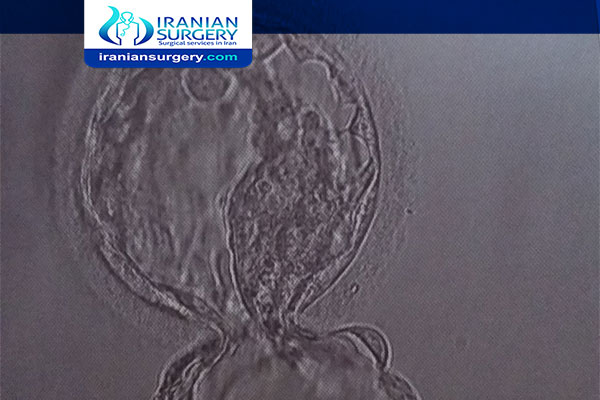
The EmbryoGlue Method If the embryo has successfully left its shell implantation in the endometrium must follow. Infertile couples considering advanced assisted reproductive treatments should consult with their reproductive specialist regarding their candidacy for assisted hatching.

Preliminary data from some research centers indicate that assisted hatching might be of value to increase embryo implantation rate in the human at least in selected cases.
Does assisted hatching make implantation faster. When the experts noticed that embryos with a thin zona pellucida had achieved a higher rate of implantation during IVF they developed a new lab technique known as assisted hatching. Under this technique an embryologist carefully observes the embryo until the third day of its development when it contains at least six to eight cells. Assisted hatching is a newer lab technique that was developed when fertility experts observed that embryos with a thin zona pellucida had a higher rate of implantation during IVF.
With assisted hatching an embryologist uses micromanipulation under a microscope to create a small hole in the zona pellucida. Preliminary data from some research centers indicate that assisted hatching might be of value to increase embryo implantation rate in the human at least in selected cases. It is not clear however whether this technique would be of benefit for all patients undergoing an embryo transfer.
I am thinking assisted hatching would speed up implantation. Does anyone know or have a cited source. I am of course in the dreaded 2ww and I am of course reading in to every little thing that happensis my dull headache a leftover from the drugs.
Yes assisted hatching is a complementary technique used in the field of assisted reproduction. It involves making a small hole in the zona pellucida Certified Medical Magazine by WMA ACSA HON. Assisted hatching can improve the chances of implantation during IVF and is considered an option for patients who are able to achieve good fertilization and embryo cell development but the zona pellucida is excessively thick and they do not conceive.
Assisted hatching is a procedure during which the embryonic shell is weakened by creating a small hole with a pipette or laser in order to facilitate the hatching process. The EmbryoGlue Method If the embryo has successfully left its shell implantation in the endometrium must follow. The AHh just makes it easier for the embie to hatch but that doesnt necessarily mean it hatches earlier.
That said I did get what I consider a real BFP and not trigger at 6dp3dt. I never actually had a day that was negative but 6dp3dt the IC was neg while the FRER later in the day was pos. Assisted hatching involves making a small opening in the protective lining surrounding the early embryo the zona pellucida either chemically or mechanically.
The procedure is thought to increase the chances of success in cases where IVF in vitro fertilisation embryos repeatedly fail. Assisted Hatching Procedure. Here is what you need to know more about the assisted hatching procedure.
Assisted hatching came about around 1990 as a way to improve the chances of implantation during IVF treatments. The procedure is performed three days after fertilisation when the embryo has had a few days to develop. We did assisted hatching with our fresh cycle day 3 embies.
The embryologist said it helped them break the tension when hatching. He said there was a very unlikely chance of harm but it. Assisted hatching can increase the likelihood of embryo implantation.
Our embryologists use laser technology to make a small hole in the zona pellucida that surrounds the embryo before its placed inside the womans uterus. This makes it easier for the embryo to attach to the uterine wall. Assisted hatching can improve pregnancy rates.
Assisted hatching with the laser is considered as safer faster and easier as compared to the other methods and it can even boost up the chances of getting pregnant during IVF process. Laser hatching can give benefit to the women with having age more than 37 with a successful IVF cycle. Does assisted hatching improve implantation rates.
ZP ablation in particular for embryo biopsy proce-dures where this hands-free technology enables a much faster and more convenient. Assisted hatching offers hope to couples who fall into these categories. Assisted hatching was developed from the observation that embryos which had a thin zona pellucida shell had a higher rate of implantation during in vitro fertilization.
It was postulated that creating a minor defect in the zona might result in a greater chance of the embryo hatching or shedding its shell allowing for a better chance of implantation. However the clinical relevance of assisted hatching remains controversial and elusive. Some research demonstrated that assisted hatching could increase implantation and pregnancy rates especially in women with a poor prognosis such as advanced age Magli et al 1998 repeated failures.
Assisted hatching has demonstrated the potential for improving embryo implantation rates and clinical pregnancy rates in select patient groups undergoing IVF. Infertile couples considering advanced assisted reproductive treatments should consult with their reproductive specialist regarding their candidacy for assisted hatching. Laser assisted hatching creates a small crack on zona before inserting the embryo in the uterus to help successful hatching and implantation leading to pregnancy.
Laser assisted hatching increases the chances of successful implantation and pregnancy from 55 to almost 65. In assisted hatching embryologists apply the observed behavior of successful natural hatching to increase the likelihood of implantation for our IVF patients. Candidates for Assisted Hatching Several factors can make someone a candidate for assisted hatching with in vitro fertilization.